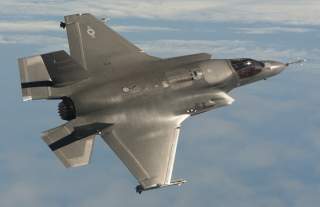A Nearly Unstoppable Combo: Adding F-35s to an Aircraft Carrier
And that's exactly what Japan is doing.
If other navies' experiences are any indication, the Izumos could embark a dozen or more F-35s plus supporting helicopters. It's worth noting that the Japanese army is buying V-22 tiltrotor transports that also could operate from the navy's carriers.
Japan's cabinet on Dec. 18, 2018 approved a plan to modify the Japanese navy's two Izumo-class helicopter carriers to embark F-35B stealth fighters.
(This first appeared several months ago year.)
The modifications should result in the Japanese fleet operating, for the first time since World War II, flattops with fixed-wing aircraft. With the two ships and their new planes, Tokyo could be able to duplicate the United Kingdom's own 1982 campaign to retake the Falkland Islands from invading Argentine forces.
"You can still do a lot with a small air wing," Eric Wertheim, an independent naval analyst and author of Combat Fleets of the World, told The National Interest. "Especially when it contains advanced stealth aircraft like the F-35B."
At the same time the Japanese cabinet approved the ship modifications, it also endorsed the purchase of 42 F-35Bs from Lockheed Martin, an acquisition that could cost up to $5 billion but should provide the Japanese air force more than enough fighters for the new carriers.
Navies tend to buy their most important ship types in twos or threes, so that at least one vessel is ready for combat while the others conduct training or undergo maintenance. But navies also plan for surge operations, in which as many ships as possible deploy for war, even if that means deferring maintenance or training.
The U.S. Navy possesses 10 Nimitz- and Ford-class supercarriers. It plans to deploy six of the ships within 30 days of a crisis, plus at least one more within 90 days.
With 42 F-35Bs, Japan conceivably could surge both Izumos.
Officials have not announced the composition of the Izumos' air wings. Japan aims to acquire its first 18 F-35Bs -- enough for one squadron -- by 2023. In the meantime, the carriers could require significant rework in order to accomodate the planes.
At the least, the Izumos' flight decks need a heat-resistant coating to protect them from the F-35B's downward-blasting lift fan, which allows the plane to take off and land vertically.
At present, Izumo and her sister ship Kaga normally embark just nine aircraft -- a mix of H-60 anti-submarine and rescue helicopters and MCH-101 minesweeping helicopters. But the 814-feet-long ships, each displacing around 27,000 tons of water while fully loaded, in theory can accommodate 28 aircraft.
If other navies' experiences are any indication, the Izumos could embark a dozen or more F-35s plus supporting helicopters. It's worth noting that the Japanese army is buying V-22 tiltrotor transports that also could operate from the navy's carriers.
The Italian navy routinely deploys six jump jets -- Harriers at present, F-35Bs in the future -- from its 800-feet-long, 30,000-ton-displacement flagship carrier Cavour. The Royal Navy's two Queen Elizabeth-class carriers, each 920 feet long and displacing 65,000 tons, could embark up to 24 F-35Bs plus helicopters.
The U.S. Marine Corps has drawn up plans to squeeze 20 F-35Bs plus helicopters and tiltrotors aboard the U.S. Navy's 850-feet, 40,000-ton Wasp- and America-class amphibious assault ships.
The Royal Navy is buying 48 F-35Bs and planning for 24 of them to be deployable at any given time while the rest are in maintenance or conduct training. With roughly the same number of fighters, the Japanese navy could form two, 12-jet wings -- one for each Izumo.
A 30,000-ton carrier with a dozen fighters could represent a significant capability. In 1982 the Royal Navy's now-decommissioned light carrier Invincible, displacing just 22,000 tons, deployed to the Falklands with eight Harriers. The 28,000-ton carrier Hermes, also long decommissioned, sailed with 12 Harriers and later added another 14 of the fighters.
"The successful defensive role played by a very limited number of British Sea Harrier fighters over the Falklands and operating from small Royal Navy carriers proved in many ways to be the decisive weapon that enabled British operations to continue in the face of withering Argentine air attacks," Wertheim said. "Small numbers of F-35Bs could play a similar role for Japan."
David Axe serves as the Defense Editor of the National Interest. He is the author of the graphic novels War Fix, War Is Boring and Machete Squad.


